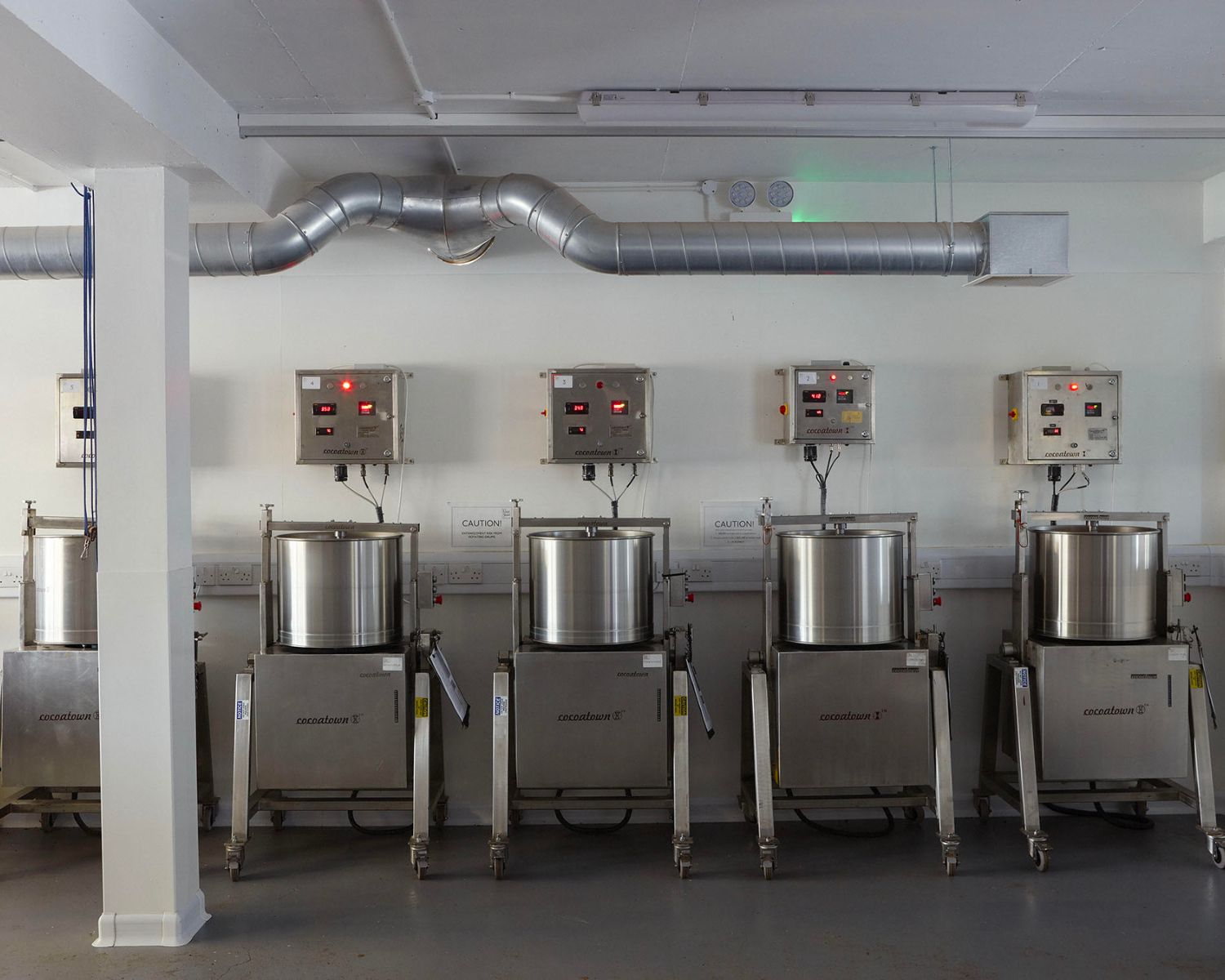FREE DELIVERY ON CHOCOLATE ORDERS OVER £35
FREE DELIVERY ON CHOCOLATE ORDERS OVER £35
SHOP CHOCOLATE
What is Craft Chocolate?
by Joanna Brennan July 10, 2023 11 min read

A brief guide to craft chocolate - written by Joanna Brennan from Pump Street Chocolate
We call ourselves craft chocolate makers - but what does that mean to us, and what does it mean in the context of the rest of the chocolate industry? While you may have tasted craft chocolate or given it as a gift, this phrase and its sister term “bean-to-bar” might remain obscure. We’ve tried to demystify the term by exploring a range of topics.
Contents:
- Our definition of craft chocolate
- The history of craft chocolate
- The ancient Mesoamerican approach to chocolate 'craft'
- The evolution of chocolate craft in Europe between the 16th and 18th centuries
- The shift from craft to industrialisation in the 19th century
- Slavery in industrialised chocolate production
- The modern craft chocolate movement
- Why craft chocolate is a confusing term
- How does craft chocolate differ from industrial chocolate?
- Why is craft chocolate so expensive?
- Why is craft chocolate important?
- Terms related to craft chocolate
Discover how to make craft chocolate for yourself
Discover the art of craft chocolate for yourself in our Exploring Craft Chocolate Class.
Craft chocolate - a definition from craft chocolate makers
To us, craft chocolate describes the making of chocolate on a smaller scale than we have been accustomed to post 20th century food industrialisation. It usually connotes a process that involves a lot of skill on the part of the maker, made by hand or small batches. Another term that is used almost interchangeably is “bean to bar”.

In reality, any definition of "craft chocolate" remains fluid. There is no widely agreed-upon understanding of what it entails, and different craft chocolate makers have differing opinions on what it truly encompasses.
Our interpretation and definition comes from our work as craft chocolate makers. It’s a term we proudly wear because we think making craft chocolate will always matter.
For those with a keen interest in understanding 'craft chocolate', it's a peeling back the layers of time, language, and practice. And for those who simply love chocolate - knowing your chocolate is ‘craft’ simply means you are part of a bigger story and philosophy that is supporting conscious consumption.
The history of craft chocolate
A chronological journey on how ‘craft chocolate’ came to be.

A metate - this one is ceremonial - used for grinding cacao by the Mesoamericans. Source: The Met Museum.
The ancient Mesoamerican approach to chocolate 'craft'
Over 5,000 years ago in what is now Ecuador, we believe chocolate was first consumed. For hundreds, indeed thousands, of years it was a commodity treasured by the Mesoamericans - a diverse group of cultures, living in an area encompassing modern-day Mexico through Central America, including societies like the Olmec, Maya, and Aztec.
These cultures revered chocolate, integrating it into various aspects of their lives. It was a central ingredient in spiritual life, served as a currency, consumed as a hot or cold drink, and was blended with a variety of spices.
The Mesoamerican preparation of cacao was the foundation of what has now been called craft chocolate making. The beans were harvested, fermented, dried, roasted, and ground into a paste — a process that required meticulous attention to detail and an intimate understanding of the raw material.
While the term did not yet exist - the techniques used by Mesoamericans undoubtedly embody the same principles we can recognise as 'craft' today. There was a focus on the bean itself, with value placed on the knowledge and ceremony of the preparation, as well as on the finished product. The methodology and the ingredients were simple, and not highly technical, yet transformational.
(For anyone interested in finding out more about this fascinating period of chocolate history, we recommend Coe and Coe. True History of Chocolate.London: Thames and Hudson, 2013. )

The Chocolate Girl (detail; c. 1744), Jean-Étienne Liotard - a maid carrying a porcelain cup filled with chocolate. Source: Apollo Magazine.
The evolution of chocolate craft in Europe between the 16th and 18th centuries
Following centuries of traditional cacao use in Mesoamerica, the world of chocolate began to transform when it arrived on European shores in the 16th century.
Initially introduced in Spain, by the 17th century chocolate was gaining popularity across all of Europe, becoming a favoured luxury item amongst the affluent.
But unlike the bitter cacao consumed by Mesoamericans - early European chocolate drinks were sweetened by adding sugar to the ground cacao, forging the way for the much sweeter profile of chocolate we know today.
This phase of European chocolate history was an intriguing blend of new influences and traditional craftsmanship. It was also the beginning of the chocolate being removed from its place of origin, and becoming a commodity - something that would contribute to the development of the chocolate as it is mostly consumed today, and also deepen the geopolitical and socioeconomic divide between the colonial chocolate drinkers and those in cocoa-growing regions.
For a more detailed timeline of this period in Britain's chocolate history, visit The Museum of Hot Chocolate. History First have also written an interesting piece about the English’s chocolate habits in the 17th-century.

We’re not sure if this is the exact bar, but it's one of the earliest images we could find. Source: Pinterest.
The shift from craft to industrialisation in the 19th century
The 19th century was an important era for the craft of chocolate making. The Industrial Revolution, with its mass production capabilities and advancements in machinery, ignited a radical shift from artisanal, small-batch chocolate making to large-scale industrial production.
A turning point came in 1847 when Fry and Sons debuted the world's first solid chocolate bar.
Soon, factories were replacing the careful hands of smaller makers and chocolate bars became common. This shift resulted in a standardisation of chocolate, with less emphasis on the individual, nuanced flavours of cacao and more focus on creating a consistent, easily replicable taste and texture.
The consequences were twofold: on one hand, it made chocolate more accessible and affordable to the general public. On the other hand, it marked a departure from the traditional craft of chocolate-making, with its emphasis on quality, variety, and respect for the provenance of raw materials.
Slavery in industrialised chocolate production
Our journey through craft chocolate's history must confront a deeply disturbing aspect - the role of slavery.
From the 17th to the 19th centuries, as Europe's demand for chocolate surged, the commodification of chocolate came at a steep human price. To meet the insatiable demand in the West, countries like Spain, Portugal, Netherlands, and Britain (among others) participated in the transatlantic slave trade. Millions of Africans were forced into gruelling labour on cocoa plantations across the Caribbean and Americas. These men, women, and children bore the harsh realities of the burgeoning industry - unseen, unpaid, and unacknowledged.
While a comprehensive account of this dark period is beyond the scope of our brief guide, we do recommend further reading for those wishing to gain a deeper understanding of chocolate's past. Online, Harper’s have archived an article by English journalist Henry Woodd Nevison who visited a cocoa plantation on the island of San Tomé. Published in February 1906, it’s titled:The slave-trade of to-day. Conclusion.–The islands of doom.
Even beyond the gradual abolition of slavery across these colonies, and the independence movement for cocoa-growing countries, the power disparity that was imposed by colonisers has continued up until the present day. Chocolate is still consumed largely outside of cocoa growing regions, and people who grow cocoa are largely underpaid and undervalued. Their importance in the production of chocolate is underplayed and the value in the chocolate chain largely stays in the hands of the middlemen, the maker and the retailer, rather than the growers themselves.
We will soon be updating the journal with a post on what we are doing to actively counteract this system of power and privilege in our cocoa sourcing, through our cost structure, in our labelling, and within our team.
The modern craft chocolate movement - the renaissance of tradition
Having briefly traced how chocolate has been ‘crafted’ throughout the centuries - we can now move into the rise and significance of the modern craft chocolate movement.
What is the modern craft chocolate movement?
The modern craft chocolate movement is an echo of the past. It exists in contrast to the changes industrialisation brought to chocolate-making in the 19th century by seeking to revive the tradition of chocolate making with a focus on taste, quality, care and attention in processing, and ethical sourcing of the cacao with appropriate respect for the place of origin, the people who work to grow cocoa, and the impact of agriculture on the land.
This change didn't happen in isolation. The modern craft chocolate movement was part of a broader renaissance in the food and drink industry, notably since the late 20th century. Terms like craft beer, artisan cheese and specialty coffee are familiar markers of this trend. Here, the key elements of ‘craft’ —quality, authenticity, and artistry—stand in bold opposition to the mass production ethos.
The craft movement then, is about a return to tradition and attention to detail in a world where these qualities are often overshadowed by speed and efficiency.
Why ‘craft chocolate’ is a confusing term
It’s clear that “craft” is where the obscurity lies. We think this stems from a few reasons.
The first is to do with the fact that ‘craft’ is frequently used interchangeably with various other terms. Think ‘artisanal’, ‘speciality’, ‘bean-to-bar’ - not to mention colloquial descriptions like ‘fancy’, ‘nice’, ‘good’ or ‘independent’. All these overlapping uses have created a kind of terminological clutter, making it harder for consumers to discern what exactly ‘craft' means in the context of chocolate.
Secondly, in order to grasp what ‘craft chocolate’ truly is, there is a need for some historical understanding. This is why we began this guide by tracing the history of chocolate making from Mesoamerica to 19th-century industrialisation. Recognising that 'craft chocolate' has its roots in these traditions and is a response to industrial shifts can help reveal its significance.
As a last point - the separation between mass and artisanal production is one of the most common ways we define craft chocolate within the industry - yet this is a delineation that isn’t necessarily immediately obvious or clear to the consumer when they’re browsing shelfs or shopping online.

Questions you might have about craft chocolate
We answer four frequently asked question about craft chocolate.
How does craft chocolate differ from industrial chocolate?
Real craft chocolate is a stark contrast to industrial chocolate. Not in a lofty nor exclusive way, rather simply by striving to improve where industrial practices often fall short. It's about better quality, better sourcing, better flavour.
You might wonder if a large corporation or chocolate factory could produce craft chocolate? Could, for instance, Nestle or Cadbury make a 'craft' bar?
Technically, anyone can label their chocolate as 'artisan' or 'craft'. In today's market it's not uncommon to see big industry brands doing this however, ‘craft’, is not an adornment to “chocolate” to make it sound nice. Or at least, it shouldn’t be. Understanding what true craft chocolate is helps us discern who truly earns that title.
Again, this isn’t about gatekeeping or elitism but about giving credit where it's due - to the farmers and chocolate makers who dedicate themselves to creating a product that’s crafted with care, attention, and responsibility.
Why is craft chocolate so expensive?
As craft chocolate makers, this is a question we’ve been asked before.
At Pump Street, we believe the answer lies in traceability and fairness. The beauty of craft chocolate is that we can trace our beans right back to the farm they came from - a level of detail and care that only a small fraction of chocolate worldwide can claim. This commitment to transparency requires an extra layer of dedication on the part of the maker, which inevitably adds to the costs.
The most significant way this contributes to the final cost is because the farmer is being paid on average four times more than they would for commodity chocolate grade beans.
Our focus on the farms is not just about tracing the origins of the beans, and ensuring great flavour, but about a rigorous approach to sustainability and ethics. We place a high value on the work of everyone involved in the process, from the farmer to the chocolate maker. Ensuring fair pay for this work means that the final product on the shelf may cost a bit more.
Yet, even with all these considerations, a bar of high-quality craft chocolate can still be purchased for under £10. While it's more expensive than mass-market bars, it's still within reach for most consumers and far more affordable than, say, a bottle of high-end wine.
If you are interested in learning more, this article by our friends at Social Pantry further captures our views on the world of luxury chocolate and how luxury is not just about packaging, or added flavours.
Why craft chocolate is important
Craft chocolate may seem like a small detail in the grand scheme of things, but it carries significant weight.
- Quality of flavour:Much like coffee or wine, craft chocolate shines a spotlight on the quality and unique flavour profiles of cacao beans. Each bean, depending on its origin, has a distinct flavour, which is then enhanced through the craftsmanship of the chocolate maker.
-
Sustainability: By focusing on small-scale production and fair practices, craft chocolate promotes sustainability in the cacao industry. Craft makers often build direct relationships with farmers, ensuring fair pay and better agricultural practices (here are 5 reasons why we call our chocolate ethical)
-
Preservation of biodiversity: Industrial chocolate production often uses hybrid cacao varieties that are resistant to disease but less flavorful. Craft chocolate, on the other hand, can help preserve heirloom cacao varieties and thus, the biodiversity of cacao.
-
Supporting local economies: When chocolate makers build direct relationships with cacao farmers, they contribute to local economies. This support can lead to better livelihoods for farming communities and a more robust, resilient local economy.
-
Transparency: Craft chocolate brings transparency to an industry that often lacks it. It encourages consumers to ask questions, understand where their food comes from, and make conscious choices.
-
Cultural preservation: Many cacao-growing regions have rich histories and traditions associated with chocolate. Craft chocolate allows these stories to be told and these traditions to be preserved.
Terms related to craft chocolate
Small-batch chocolate: This term refers to chocolate that is made in limited quantities, often by independent makers. The process involves carefully controlled steps, allowing for variations in flavours and quality that differ significantly from mass-produced chocolates.
Small-batch chocolate makers often prioritise quality over quantity, and this approach allows them to closely monitor each step of the production process. The amount that constitutes a small batch is subjective, but is widely understood to be under 100kg, with most small batch makers using machines that make about 30kg at a time.
Bean-to-bar chocolate: This term describes the process of making chocolate from scratch, starting with cacao beans and ending with a finished chocolate bar. The term was started to refer to a maker or a small team of makers controlling every step of the process - from sourcing the beans, roasting, grinding, refining, conching, tempering, to moulding the bars.
Emphasised, is a commitment to high quality, ethical sourcing, and transparency in the chocolate making process, although this term has often now been adopted by bigger industrial makers, who in a literal sense, do make chocolate from a bean, to a finished bar.
Single-origin chocolate: This refers to chocolate that's made from cacao beans grown in one specific geographical region, often a single country or a particular area within a country. The unique climate, soil, and cultivation methods of each region can lend distinct flavours to the beans, similar to how wine grapes take on the characteristics of their terroir. Find out more about the origins we work with for our single origin chocolate.
Single-farm chocolate: This term takes the concept of single-origin a step further. Single-farm or single-estate chocolates are made from cacao beans sourced from one specific farm or estate. This allows for an even more distinct flavour profile and gives the chocolate maker more control over the quality and ethical sourcing of the cacao. It also provides a direct benefit to the farmers who grow the cacao, as their hard work and dedication to the cultivation process are highlighted and recognised.
Subscribe
Sign up to get the latest on sales, new releases and more …


